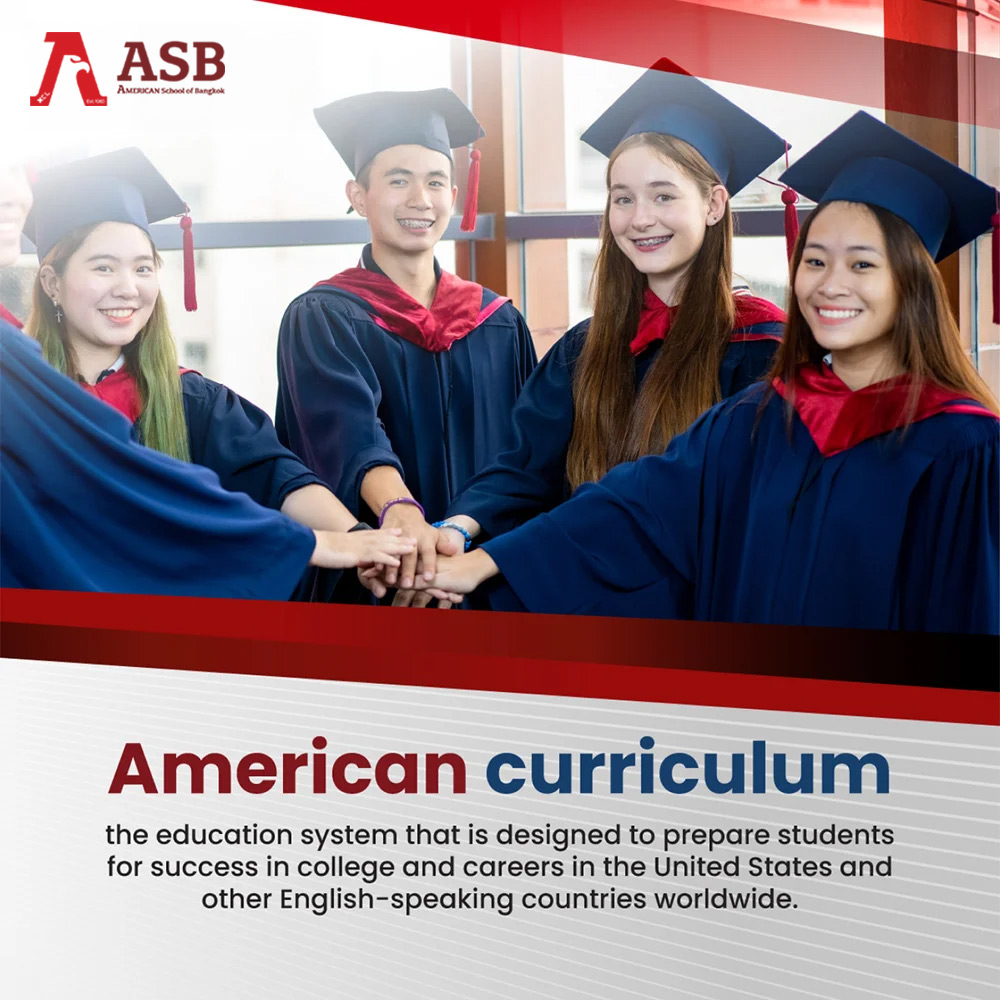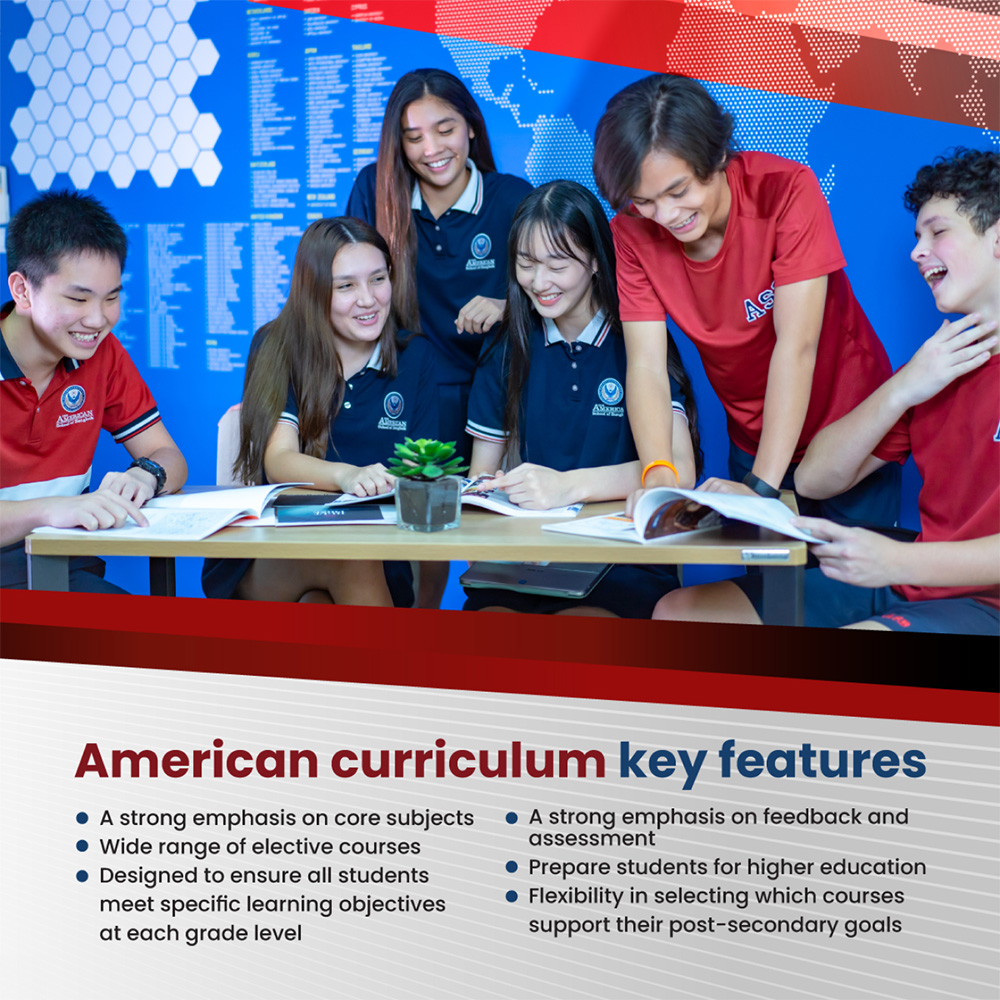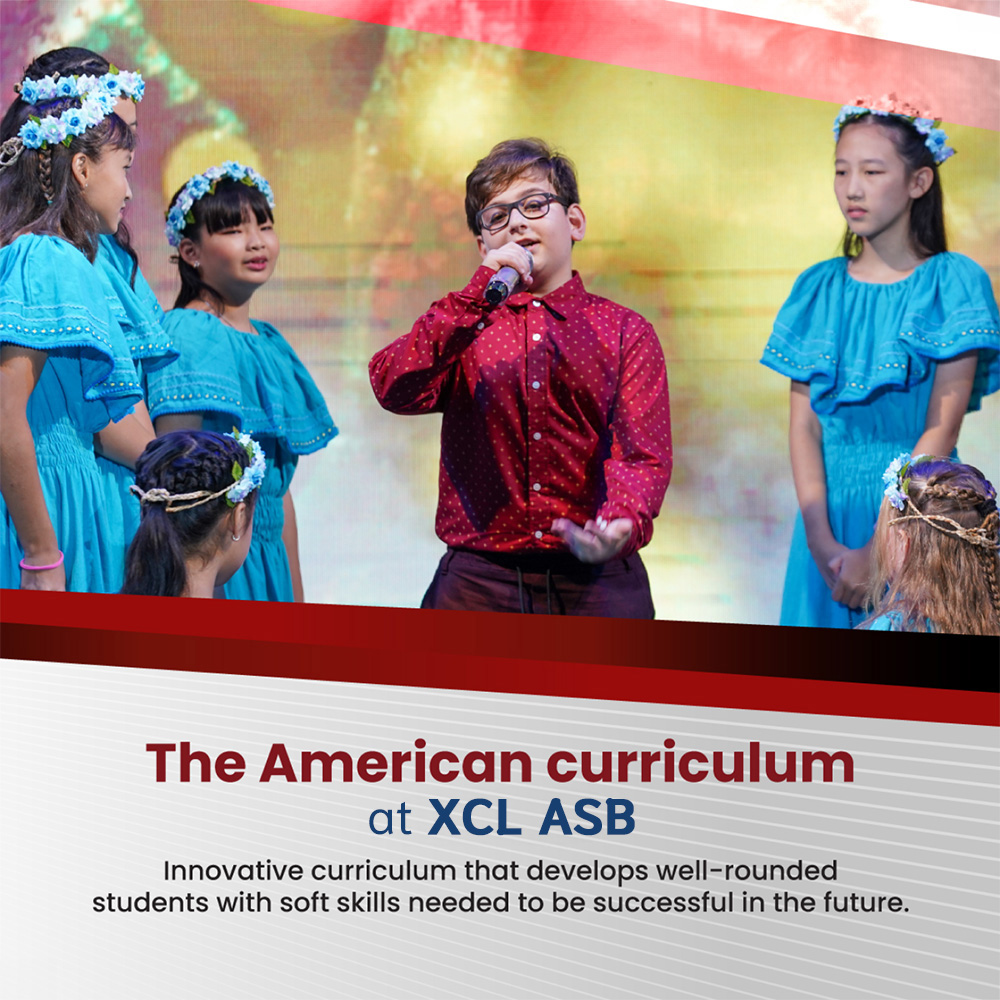
An Overview of American Curriculum

American Curriculum Key Features
- Core Subjects: The American curriculum places a strong emphasis on core subjects, including English Language Arts, Mathematics, Science, and Social studies.
- Electives: In addition to core subjects, students are also offered a wide range of elective courses, including athletics, world languages, art, music, and design technology.
- Standards-based: The American curriculum is standards-based, meaning that it is designed to ensure that all students meet specific learning objectives at each grade level.
- Assessment: The American curriculum places a strong emphasis on feedback and assessment, with ongoing and varied appraisals of established learning outcomes.
- College-preparatory: The American curriculum at XCL American School of Bangkok is designed to prepare students for higher education, with a focus on developing critical thinking, problem-solving, and communication skills.
- Flexibility: While there is a standardized curriculum, schools and teachers have some flexibility in how they teach and how they structure their courses. Families and students also have flexibility in selecting which courses support their post-secondary goals.

XCL ASB graduates attend 99 different universities and
colleges in 20 countries, in America, Europe,
and across Asia

American Curriculum at XCL ASB


FAQs
The American curriculum is not the same as the International Baccalaureate (IB) curriculum. They are two distinct educational frameworks with different structures and philosophies.
The American curriculum refers to the educational system followed in schools across the United States. It typically consists of a set of standards and guidelines established by individual states or school districts. The American curriculum places emphasis on core subjects such as English, mathematics, science, and social studies, along with a wide range of elective courses. It is generally structured around grade levels, leading to a high school diploma upon completion of the required credits and acceptance to universities worldwide.
On the other hand, the International Baccalaureate (IB) is an internationally recognized educational program offered in schools worldwide. It is designed to provide a comprehensive and rigorous education that prepares students for higher education and encourages international-mindedness. The IB curriculum includes four programs: the Primary Years Programme (PYP) for ages 3-12, the Middle Years Programme (MYP) for ages 11-16, the Diploma Programme (DP) for ages 16-19, and the Career-related Programme (CP) for ages 16-19. Each program has its own unique characteristics and requirements, but they all focus on holistic education, critical thinking, and intercultural understanding.
Here are some key differences between the American and British curriculums to help you make an informed decision:
- Structure: The American curriculum typically follows a semester or trimester system, while the British curriculum follows an academic year. The American curriculum tends to be more flexible, with a wider range of courses and electives available, while the British curriculum is more structured, with a set curriculum that is followed by all schools.
- Testing and Assessment: The American curriculum places more emphasis on testing and assessment, with standardized tests like the SAT and ACT being a key factor in college admissions. The British curriculum places more emphasis on coursework and exams, with students taking a series of national exams called GCSEs and A-levels.
- Teaching Style: The American curriculum tends to focus on interactive teaching methods, with a lot of group work, projects, and presentations. The British curriculum places more emphasis on traditional teaching methods, with students learning through lectures, class discussions, and independent study.
- Content: The American curriculum tends to cover a wider range of topics, including more courses in the social sciences, humanities, and the arts. The British curriculum places more emphasis on core subjects like math, science, and English, with less emphasis on electives and interdisciplinary courses.
- Global Perspective: The American curriculum places more emphasis on global issues and multiculturalism, with a focus on developing students’ cultural awareness and understanding. The British curriculum places more emphasis on British history and culture, with less focus on global issues.
The American curriculum is designed to prepare students for college and careers by providing them with a strong academic foundation, essential skills, and opportunities for personal and professional growth.
Here are some key ways in which the American curriculum supports college and career readiness:
- Broad range of subjects: The American curriculum offers a diverse range of subjects, including English, mathematics, science, social studies, foreign languages, arts, and physical education. This comprehensive approach helps students develop a well-rounded knowledge base and prepares them for various academic and career paths.
- College-preparatory courses: Many American high schools offer advanced placement (AP) courses or honors courses that provide rigorous academic content and may grant college credit. These courses allow students to challenge themselves academically and demonstrate their readiness for college-level work.
- Standardized testing: The American curriculum often includes test preparation and strategies to help students perform well on these exams, which can enhance their college prospects.
- College counseling and guidance: American schools provide college counseling services to support students in the college application process. Counselors offer guidance on choosing suitable colleges, writing application essays, and preparing for interviews. They also assist students in exploring career options and making informed decisions about their future.
- Extracurricular activities: American schools place importance on extracurricular activities such as sports, clubs, arts, and community service. These activities help students develop leadership skills, teamwork, time management, and other qualities highly valued by colleges and employers.
- Career exploration and internships: American schools offer career exploration programs, internships, or work-based learning opportunities. These initiatives expose students to different career paths, allow them to gain practical experience, and help them make informed decisions about their future careers.
- Soft skills development: The American curriculum emphasizes the development of essential soft skills like critical thinking, communication, collaboration, problem-solving, and adaptability. These skills are highly valued in both college and the workforce, as they enable students to succeed academically, socially, and professionally.
- College partnerships and dual enrollment: American high schools have partnerships with local colleges and universities, allowing students to take college-level courses or participate in dual enrollment programs. This provides students with a head start on their college education and can save them time and money in the long run.
By providing a comprehensive education, support for college applications, and opportunities for personal and professional growth, the American curriculum aims to equip students with the knowledge, skills, and experiences needed for success in college and future careers.











